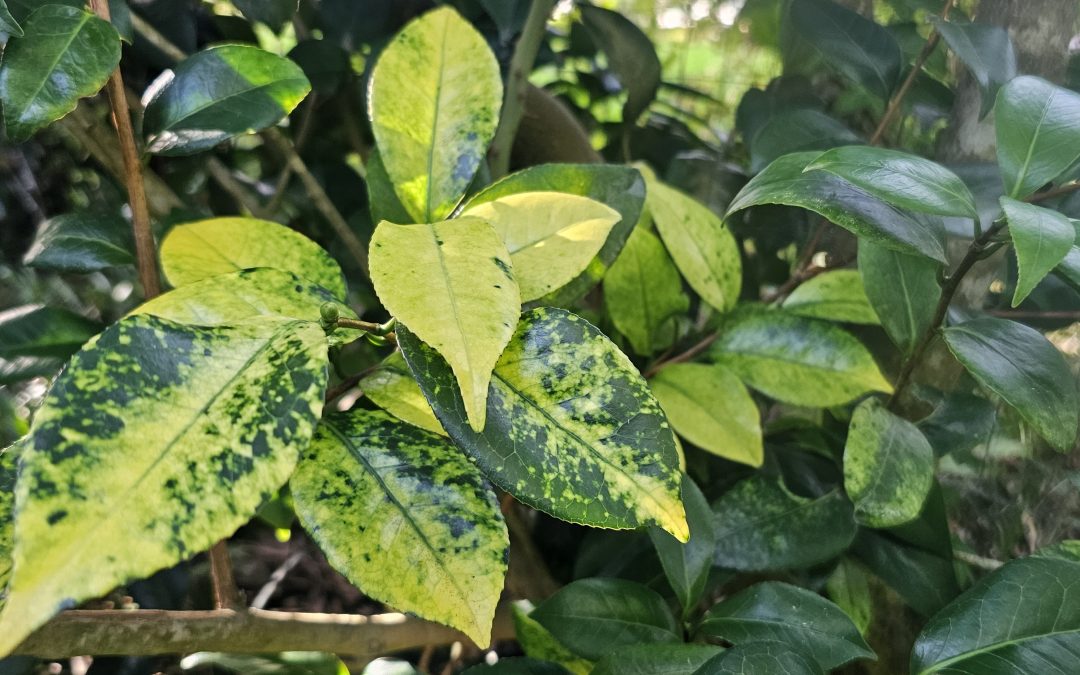
by Evan Anderson | Jun 27, 2024
An interesting phenomenon turned up in my camellia this spring. What has, for years, been a perfectly normal bush – growing its glossy, dark green leaves year ‘round and its showy flowers in the fall – suddenly changed. Its leaves started becoming variegated!
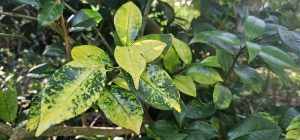
Symptoms of Camellia Yellow Leaf Mottle Virus.
Variegation refers to different colored areas of plant tissue. Most commonly, a plant will have stripes or patches of white leaf tissue along with the normal green. Sometimes, colors can vary or the placement can include stems or fruit. Many cultivated varieties of ornamental plants are selected for these interesting patterns, and sometimes food crops as well. A novel, attractive pattern can make for a very profitable plant. In the 1630s, the price of variegated tulips skyrocketed for several years in the Netherlands. During this period of ‘tulip mania’, a single tulip bulb could potentially sell for ten times the annual income of a skilled artisan. Imagine paying $200,000 for one flower!
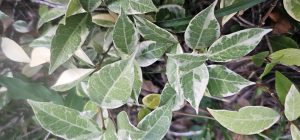
A variegated variety of star jasmine, propagated for its coloration.
Some variegations are caused by genetic mutations. Plants that are chimeras have cells with different genetic makeups. These varieties must be propagated by cutting or grafting to preserve both sets of genes. Even if successfully propagated, sometimes individual leaves or branches of these plants might lose one color or the other. A leaf that is completely white won’t thrive; it contains no chlorophyll, which gathers energy from sunlight. A leaf that becomes completely green may outcompete the rest of the variegated plant, leading to a loss of variegation over time.
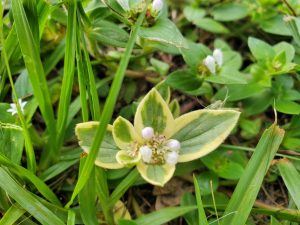
A randomly occurring genetic mutation in Florida pusley, a common weed of lawns.
Other variegations, such as those Dutch tulips and my camellia, are caused by viruses. Most are not desirable, as they decrease the health of the plant even if they don’t kill it outright. Others will quickly lead to decline and death. A mosaic virus, for example, might make your tomato leaves look interesting, but it will eventually kill the plant. In the case of a camellia, ‘camellia yellow leaf mottle virus’ is usually transmitted during the propagation or grafting process, whether intentionally or not. Camellias affected by this virus are usually not harmed, though a lack of chlorophyll in leaves leads to less energy for the plant to use in growth and producing flowers. Still, sometimes the tradeoff for fancy foliage is worth it!
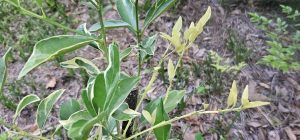
Some branches on variegated plants may turn completely white (or green).
My camellia must have received a bug bite that transmitted the virus, as I haven’t done any grafting on it. I’ve noticed a few others nearby with similar symptoms. If you see this starting on your plant, you may be able to prune out the affected area before it spreads. Make sure to sanitize pruning equipment with alcohol between cuts, and dispose of infected material if you do remove it. For other unwanted viruses, the solution may be a bit more extreme. If you cannot prevent infection in the first place through sanitation and insect control, disposal of the entire plant is often the only option that will keep the virus from spreading to other nearby plants. For any plant disease or pest issue, scout regularly and address the issue before it becomes too big. Consult your local Extension office for information or check out our EDIS publications on specific topics at https://edis.ifas.ufl.edu/.
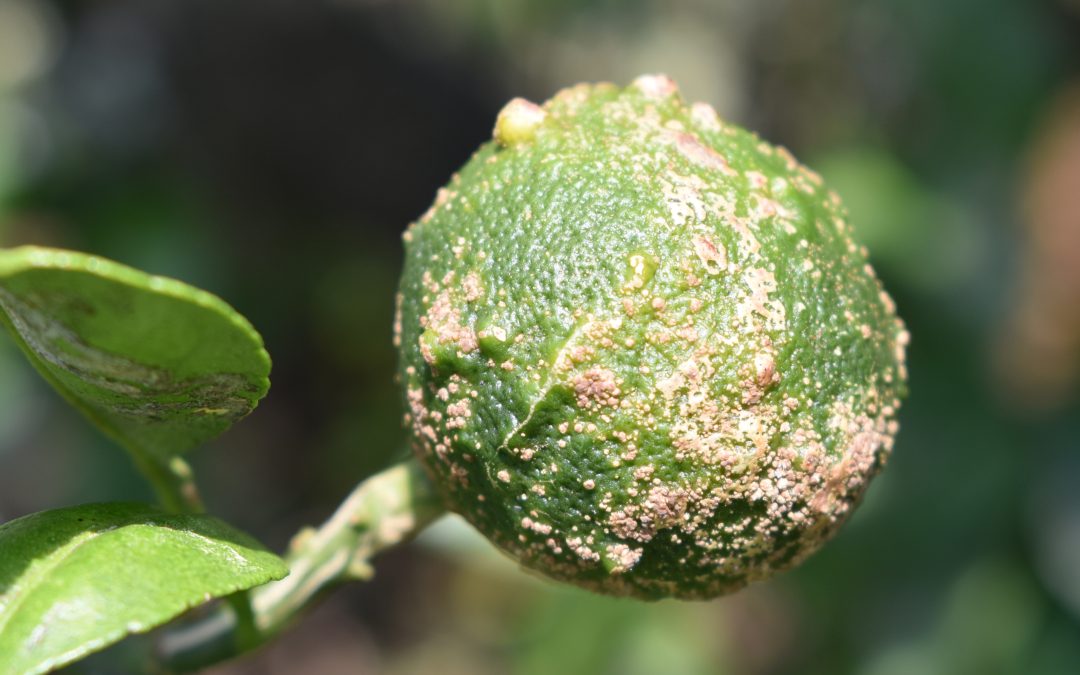
by Danielle S. Williams | Jun 27, 2024
Citrus scab, caused by the fungal pathogen Elsinoë fawcettii, is a common disease affecting citrus trees in the home landscape such as satsuma mandarins, tangelos, grapefruit, and other tangerine hybrids. This disease affects the leaves, fruit, and twigs of citrus trees, creating unattractive, wart-like lesions. While citrus scab is rarely fatal to the tree, it can reduce the quality and marketability of the fruit.
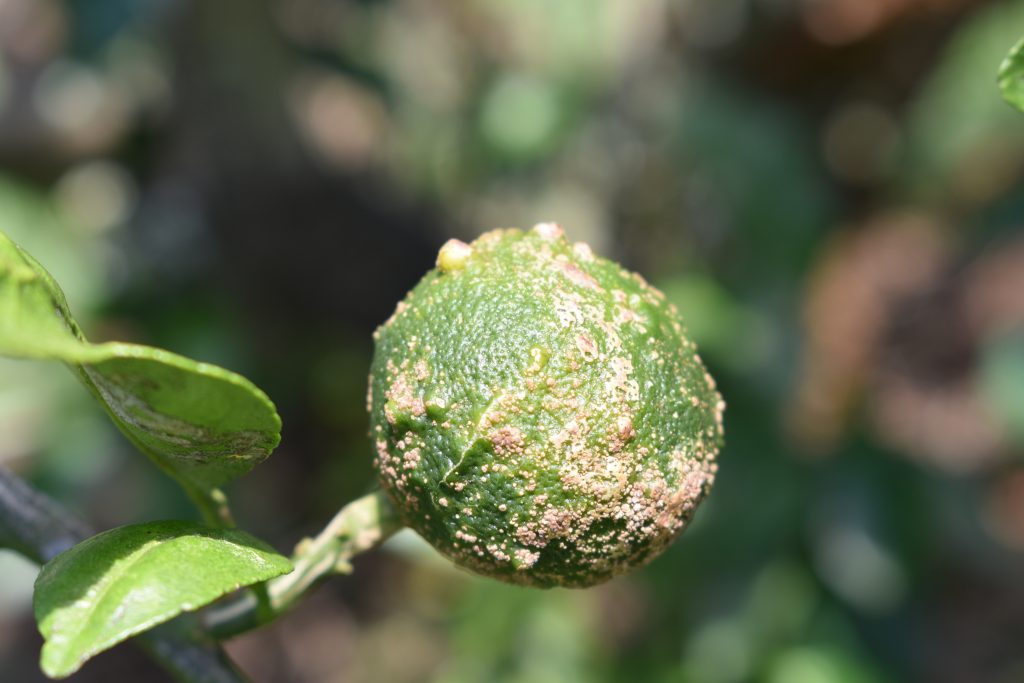
Citrus scab on young satsuma mandarin fruit. Photo Credit: Danielle Williams
Identification and Symptoms
The most noticeable symptom of citrus scab is the development of corky, irregularly shaped lesions on the surfaces of leaves and fruit. These lesions start as small, pale, slightly raised areas that gradually enlarge and turn dark brown to light gray. On leaves, the lesions often appear on the lower surface, giving them a warty appearance. Fruit may exhibit scab lesions, which can cause deformities and discoloration, making them less appealing for consumption, however it does not make the fruit inedible.
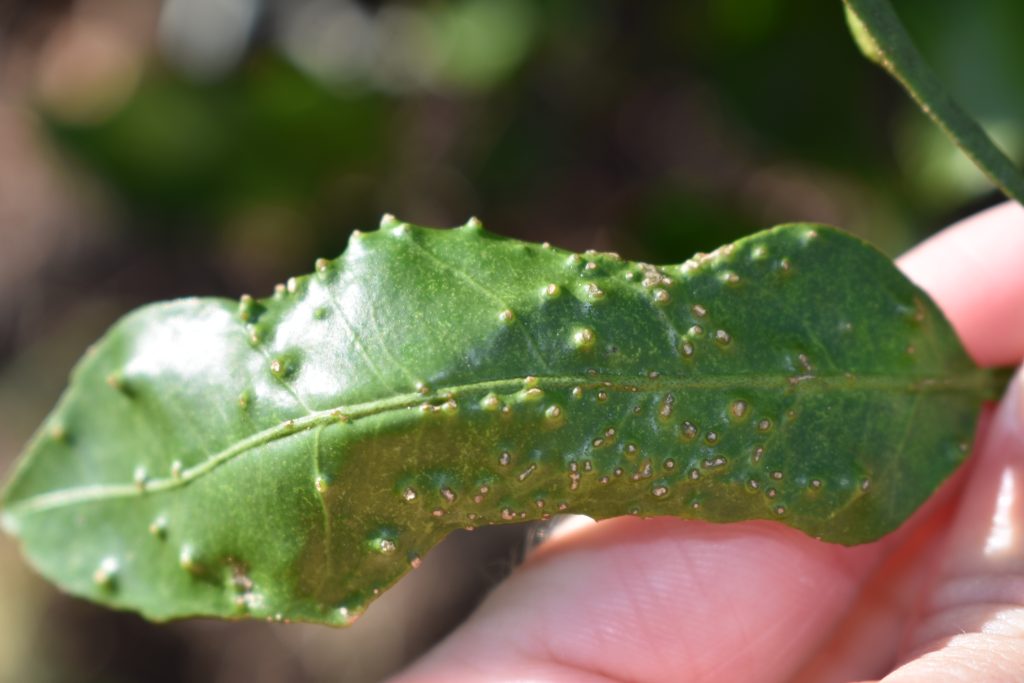
Raised lesions of citrus scab on leaf. Photo Credit: Danielle Williams.
Understanding the Disease Cycle
Citrus scab thrives in warm, moist conditions and is primarily spread through wind-driven rain that carries the fungal spores to new infection sites. The spores can overwinter in infected plant debris and on asymptomatic parts of the tree, leading to new infections during the growing season. Recognizing this cycle can help residents take preventative measures during critical times of the year.
Management and Control
To keep citrus scab at bay, homeowners should employ a combination of cultural practices as well as careful chemical use when necessary.
Cultural Practices
- Sanitation: Regularly remove and dispose of fallen leaves, fruit, and other plant debris to reduce the number of overwintering spores. This practice is particularly important in the fall and early spring.
- Pruning: Prune the tree to improve air circulation within the canopy. This reduces humidity levels around the foliage, making the environment less conducive to fungal growth.
- Irrigation Management: Avoid overhead irrigation. Overhead watering can splash spores onto healthy tissue, spreading the infection. Instead, water trees at the root zone or use microsprinkler irrigation.
Chemical Control:
- Fungicides: Applying fungicides can help protect new growth from infection. Copper-based fungicides are commonly used and can be effective. It is important to read and follow the product label on application timing and directions for use. Typically, fungicides for controlling scab should be applied in early spring when new growth begins.
Conclusion
Regularly inspect your citrus trees for signs of citrus scab, especially after periods of rain and humidity. Early detection and treatment are crucial to prevent widespread infection. Maintaining a healthy tree through proper fertilization, watering, and pest management can also reduce the tree’s susceptibility to diseases like citrus scab.
For more information, please visit:
HS-867/HS132: Citrus Culture in the Home Landscape (ufl.edu)
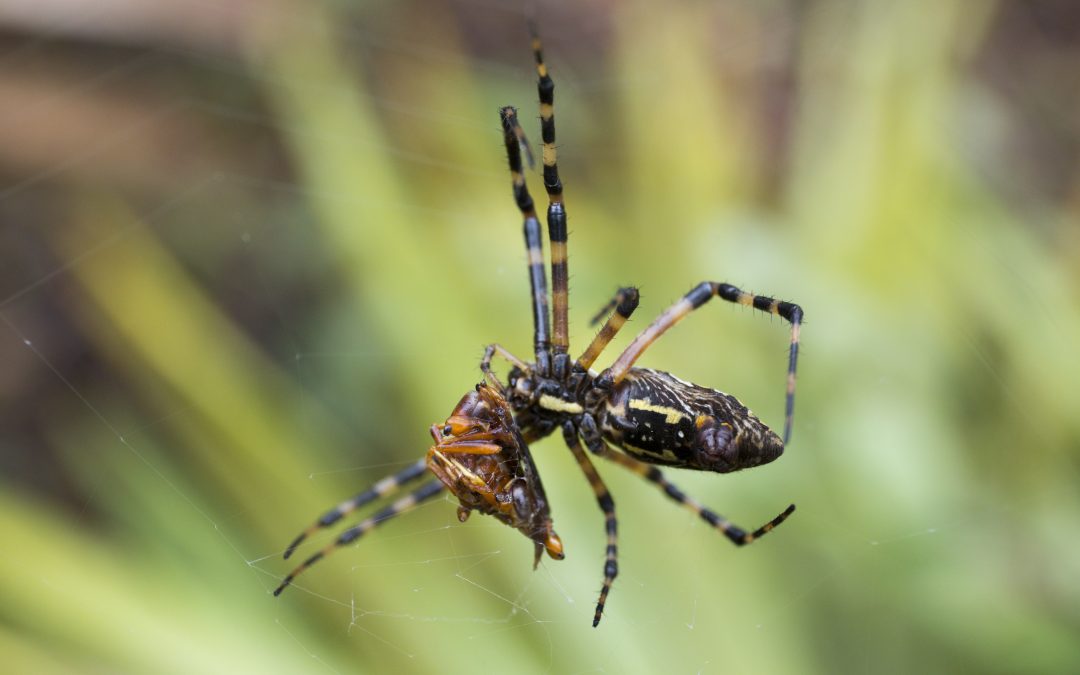
by Matt Lollar | Jun 20, 2024
It seems like I’m always finding a unique spider in the house. Whether I’ve been summoned to remove it from the premises or by a chance encounter. It is no surprise to me that there are more than 250 species of spiders found in Florida. In fact, I figured there were quite a bit more. Some spiders are aggressive, some have extreme patience, and others aren’t even spiders at all. Continue reading for some interesting facts about a few of the most common spiders in North Florida.
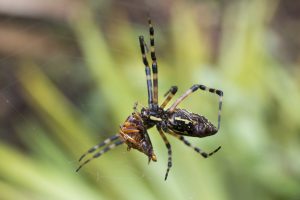
A golden silk orb-weaver spider with captured prey. Photo Credit: Tyler Jones, University of Florida.
Golden Silk Orb Weaver (Trichonephila Clavipes)
I grew referring to orb weavers as banana spiders. I guess I wasn’t the only one, because banana spiders are another one of their common names. Orb weavers are known for making big webs and producing really strong silk. Female spiders usually have other, smaller spiders occupying their webs. Male orb weavers are roughly a quarter the size of their female counterparts. In addition to the orb weaver couple on the web, small kleptoparasitic dewdrop spiders in the genus Argyrodes can be found eating bits and pieces of prey left behind.
Southern House Spider (Kukulcania hibernalis)
The brown recluse is a spider we can live without. Fortunately, they’re not very common in Florida. However, male southern house spiders are often mistaken for recluse spiders. If you want to be sure, just count the number of eyes. House spiders have eight eyes, whereas brown recluses only have six. Female southern house spiders don’t look like recluses or male southern house spiders at all. The females are dark brown with thick bodies and males are lanky and light brown. These spiders build thick webs in wall corners and the edges of windows.
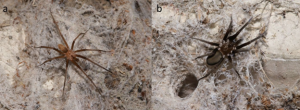
Male (a) and female (b) southern house spider (Kukulcania hibernalis) The male is light brown with long pedipalps, while the female is a dark velvety brown with shorter pedipalps.
Photo Credit: Erin C. Powell, FDACS-DPI
Harvestmen (Opiliones Family)
Everyone has seen a “daddy long legs” spider or at least we think we have. We may sometimes refer to harvestmen as “daddy long legs” spider, but they’re not even spiders at all. Harvestmen are classified as arachnids like spiders, scorpions, and mites, but they come from a different family (Opiliones). They only have one body segment, instead of two, they have no venom glands, and they can’t produce silk. And if anyone tells you they are the most venomous spider but can’t bit humans because their mouths are too small – well you know what to tell them. And there is such a thing as a cellar spider (Pholcus spp.) that has long legs, two body segments, and is also referred to as a “daddy long legs”, but what’s the fun in that.
We could go on and on about all the different spiders that can be found in and around your home, or not. If you are interested in other common spiders in Florida, then you should check out the UF/IFAS publication “An Introduction to Some Common and Charismatic Florida Spiders”. Then you’ll know exactly what’s lurking around the corner.
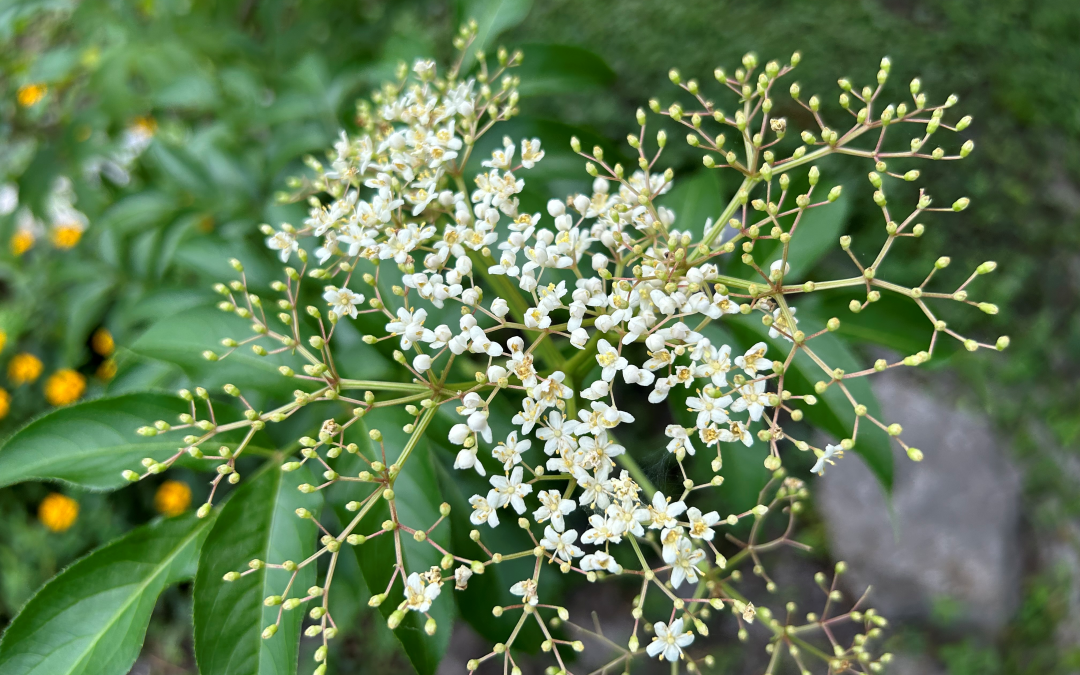
by Ian Stone | Jun 20, 2024
If you are out and about this time of year you may notice an interesting flowering shrub putting on a show of white flower heads. As time goes on the flower will develop into dark purple almost black fruit. You often find this shrub in forests, the edge of fields and pastures, and along roadsides. This attractive and very useful plant is the elderberry: Sambucus canadensis. It goes by the other common names of American or Common elderberry or simply elder or elder tree. It is native to North and South America from Canada to Brazil, and all over it’s range it is used by indigenous and local communities for a wide variety of uses. It has both food and beverage uses and medicinal uses. It grows in and tolerates a wide variety of conditions, and is quite easy to cultivate in the landscape or allow to thrive in wild areas. It also puts on a nice early summer flower show and is quite attractive. It can be weedy at times and is not always welcome in pastures as it can be toxic to livestock. Despite its medicinal applications and edible fruit, it bears caution as the leaves, twigs, roots, and unripe fruit are quite toxic to humans as well as bearing several toxic compounds not the least of which is glycosides which are in the cyanide family of chemicals. With care and knowledge though, the flowers and ripe fruits can be used and are frequently used to flavor beverages, dye food, make preserves and jellies, wine, and even many home remedies.
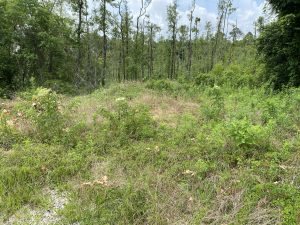
Naturally growing Elderberry in the Florida Panhandle. Photo Credit: Ian Stone
I have looked for and used this plant my whole life. My grandmother grew up on a very rural farm in Louisiana and passed on a whole host of information on useful plants and how to make a variety of home remedies. I was lucky to grow up with someone of a generation where they retained and passed on this knowledge. We never planted or grew elderberry as there was plenty growing wild all over my home area of Louisiana’s Florida Parishes. The same is true all across the Gulf Coast, and June is a good time to spot patches as it is putting on its show of white flowerheads. I always knew about its benefits and uses, and also it’s toxicity and learned much more about elderberry in forestry school. As time went on, I learned people were collecting this wild and also starting to cultivate and grow it as a crop. A family acquaintance in Livingston Parish, LA started a business growing elder and selling syrups, tinctures, and other products. I have even seen their products locally in the Panhandle now at herbal remedy and other stores. Now I go in even chain pharmacies and big box stores and see elderberry products produced on a large commercial scale. I’m glad to see a native plant develop into such a market. For the home landscape and garden, it can make an attractive edition that can then be added to the landscape and cultivated. You can enjoy the flowers and fruits yourself and make your own homemade products from them, or you can leave them for local wildlife that also benefit from them.
If you have a farm or property in the Panhandle it is likely elderberry is growing somewhere. If it is not on your property, you can easily plant and grow it in your garden, homestead, or home landscape. Be aware though it can be aggressive and spready in good growing conditions. It is also fast growing so you have to stay on top of it in cultivated settings. If you are looking to see if you have wild elderberry growing; look for the showy white flower heads on a small shrub to low tree. It has distinctive corky dots on its bark which are called lenticels. The leaves are pinnately compound with serrated margins. The fruit is bright green when unripe turning purple-black when ripe. Only fully ripe fruit are edible and safe, with a ripening period of mid to late summer. There now exists several cultivars of elderberry in the horticultural trade which are available at nurseries that stock native plants.
If you are interested in learning more about elderberry, check out this publication in the IFAS Gardening Solutions page https://gardeningsolutions.ifas.ufl.edu/plants/edibles/fruits/elderberry/. There is also a good EDIS publication available at this link https://edis.ifas.ufl.edu/publication/ST578. If you are planning on foraging wildflowers or berries and using them use caution, get a good knowledge of how to identify the plants, avoid poisonous parts and unripe berries. As with all wild foraging, only forage if you are well-informed on what you are looking for, dangerous look-a-likes, and how to avoid toxicity issues due to unripe fruit or toxic plant parts. With elderberry there are several severely toxic look-a-like plants, particularly the water hemlock one of the most toxic plants in North America. Use a good field guide and properly vetted resources and if in doubt do not gather or consume.
If you are planning on cultivating elderberry, consider selecting cultivars and varieties specifically for cultivation and fruit production. You will get better results over wild varieties, and fruit ripening will be more uniform making harvesting easier. In cultivated settings it will require care and monitoring for some pest and disease issues as well. It is well suited for marginal conditions where some other fruit options are limited and difficult to cultivate. It’s tolerance of a wide variety of growing conditions means there is likely a place in your garden or landscape that it can fit. An added benefit is that it requires less fertilization and intensive management compared to some other options. For more detailed information on cultivation see this EDIS article https://edis.ifas.ufl.edu/publication/HS1390.
Whether you have it growing naturally or are going to cultivate it, elderberry is a very attractive native plant with some beneficial and tasty uses. Elderberry wine, syrups, and preserves are quite tasty and provide many health benefits. Some people use the flower as a flavoring and to make tonics, but this requires caution to avoid poisonous parts contaminating batches. Elderberries are high in vitamin C and contain antioxidants and other medicinal compounds and are often used as cold and flu remedies as well as other ailments. If you do not have experience with making elder products at home; work with someone that is knowledgeable and experienced before making your own, especially with this plant. You can also buy certified products for sale in health stores and even at your local pharmacies now that are tested and known to be safe. Enjoy the attractiveness and usefulness of our native American Elderberry, it is a fascinatingly useful plant.

by Beth Bolles | Jun 20, 2024
The May Gardening in the Panhandle Live focused on the various aspects of turfgrass care and species characteristics.
The panel included:
Dr. Bryan Unruh, UF IFAS Extension Turfgrass Science Professor
Sheila Dunning, UF IFAS Extension Commercial Horticulture Agent in Okaloosa County
Josh Criss, UF IFAS Extension Residential Horticulture Agent in Santa Rosa County
Daniel Leonard, UF IFAS Extension Horticulture Agent and Director in Calhoun County
Q: Does No Mow March cause more problems in maintaining a good lawn?
Pay attention to what you are leaving behind. If you have aggressive perennial weeds, that could cause issues later. Also, be aware of what types of weeds. Annual wildflowers may be acceptable that will reseed next year. Mowing before seeds mature is always an option too.
Remember that if there are significant weeds, they are taking advantage of a void in the turf. Find out why the turf is not growing as well and work on that issue. Improve the health of the grass to have less issues with some weeds.
References: https://apnews.com/article/gardening-no-mow-may-lawns-6aa1669b9e9bb5b5d8ea671c44d186f2
Q: What is an unhealthy lawn?
Grass that is not performing at a level that is normal for that turf. Not growing well, does not have appropriate color for the species, thinning out. The difficult part is figuring out why. Could be that that turf is not suited to the site, cultural practices are an issue, pest problem.
We tend to manage turf too much. Take a more minimalistic approach and as needed for turf management instead of a scheduled maintenance plan.
Q: Fertilizer and pesticide inputs aside, can ornamental lawns provide environmental benefits such as carbon sequestration?
Plants remove CO2 and supply O2. Turf areas can reduce temperatures, serve as erosion management and build soil. Also filtering some pollutants. Turfgrass also has huge potential to accumulate and store carbon. Turf has many recreational uses that other surfaces don’t offer and the overall aesthetics of a healthy lawn can improve value of the property.
References: Turf Management to Protect the Environment, https://www.youtube.com/watch?v=w2ajI-t4EoY
Q: What is the best grass for Florida?
You have to match the turf to an appropriate site and turfgrass may not be the best choice for a site. On an urban site, shade from trees will also dictate if turf is appropriate. The best grass for the back yard may not be the best suited for the front yard.
Centipedegrass is a good selection for the case of a grass that grows well with low inputs. It will be a lighter shade of green which is its natural color.
If you prefer to have inputs of fertilizer and water routinely, centipedegrass would not be the best choice. Zoysiagrass is more suited for those who desire a more magazine cover type lawn that is well manicured.
A field type lawn is best with bahiagrass.
Q: Is zoysiagrass the fastest growing market for turfgrass?
There are now good zoysiagrass varieties on the market and better ones coming along.
Zoysiagrass is a very drought tolerant species but it survives by going into dormancy. It survives without water by going from green to bluishgray to brown very quickly. In order to maintain a green, well manicured zoysiagrass lawn, irrigation input is needed.
Q: Can I grow a lawn from centipedegrass seed? How long will it take to fill in?
It takes 3 years to establish a lawn from centipedgrass seeding. That is with minimal inputs but mowing is important in the establishment process.
Dr. Unruh does not recommend seeding into patches because water needs for seed are higher than established grass. Sodding or plugging is better for patching spots.
Q: What is the best choice of grass for a partly shaded lawn/best under a large tree?
Long term, you need a shade tolerant grass such as one of the St. Augustinegrasses or certain cultivars of zoysia (Palisades is one). As the tree grows over the years, grass may not remain suited for that location.
Q: What type of grass would you recommend for a meadow area that would be natural/unmowed?
Bahiagrass is a good option.
Q: How do we encourage bee lawns?
Centipedegrass flowers will attract some bees. Clovers (Red, white, hopclover) in the winter months through spring. Consider your space. May just be small sections or at the edge of the yard.
Q: How often should you aerate your lawn and what is the best method?
Sandy soils can compact. Every other year aeration if you have traffic patterns from vehicles, play, or paths. Use a ½ tine with lots of holes back and forth over the lawn.
Q: How to maintain a healthy lawn in our hot and humid summers?
Overwatering is common. Grass gives signs of needing water such as leaf blades folding in half, a color change, and grass not recovering after walking. Calibrate your system to apply ½ to ¾ inch at each time.
References: Mowing Your Florida Lawn, https://edis.ifas.ufl.edu/publication/LH028
Q: How to measure water volume with an automatic irrigation system.
In a zone, randomly place 10-15 straight edged cans that are all the same size. Run your system for a set time and see how much is in each can. You will be able to see where coverage is poor, just right, and overlapping too much. Measure with a ruler and average out the amount. Adjust your time to meet ½ to ¾ inch.
Each zone is calibrated separately.
Same for zoysiagrass but this grass will show you where your system is not functioning well since it’s response to drought is to go dormant. Still ½ to ¾ inch as needed.
References: Watering Your Florida Lawn, https://edis.ifas.ufl.edu/publication/LH025
Calibrating Your Sprinkler System, https://gardeningsolutions.ifas.ufl.edu/care/irrigation/calibrating-your-irrigation-system/
Q: Do I have to fertilize and apply pesticides to have a healthy lawn?
No. All plants need nutrition and fertilizer is just one source of nutrition. A good soil can provide sufficient levels of nutrients for the lawn. Sandy soils may need supplemental nutrients. Could be from compost incorporated in as well.
References: The Florida Fertilizer Label, https://edis.ifas.ufl.edu/publication/SS170
Q: My yard is a mix of grasses. Is this a problem for fertilizer and watering?
You may need to fertilize differently depending on the needs of the various grasses. If a grass is growing into another, then it is favorable conditions for that grass – sunlight, mowing, water availability. You may have to manage for the one that is doing the best.
Q: Should I bag my mowing clippings for my Zoysia lawn or not?
Generally the recommendation is to allow clipping to fall for a yard that is being routinely mowed. Blades will compost. The exception is with zoysia when thatch is becoming a problem or when you have neglected mowing for a period and clumps of clipping are piled on the lawn.
References: Zoysiagrass for Lawns, https://edis.ifas.ufl.edu/publication/LH011
Q: Is weed control beneficial or harmful?
Improperly used herbicides could have environmental impacts. Follow the label carefully. Manage weeds through cultural practices too.
Q: How do I get rid of crabgrass?
Annual weed that germinates when soil temps reach 55 degrees F. Could be mid-January or a little later. Pre-emergent herbicides can help. Not many options for post emergent weed control.
From Dr. Unruh: We do not recommend Weed and Feed products since timing is different for both. North Florida fertilizer applications should not occur before mid-April.
0-0-7 with pre-emergent would be the only exception. The 0-0-7 is just potassium.
Q: How to detect, kill and prevent ground pearls.
There are no chemicals controls for ground pearls. Thinning out areas. Insects that are in the soil, with pearl stage attached to the roots. Females are hot pink and crawlers.
Maybe something in the future. Try to outgrow ground pearls with faster growing grasses such as St. Augustinegrass and zoysiagrass.
Q: How do you control a heavy infestation of doveweed?
Do not handpull. Annual weed that germinates later when soils reach 70 degrees F. Pre-emergent herbicides. Mow more often and manage irrigation. Improve drainage. Clean mowers too.
Q: Are there herbicides that will not harm birds?
Insecticides have the biggest impact on wildlife compared to other types of pesticides. Many herbicides use a carrier that looks like a grain so water immediately according to label to move chemical off carrier. Follow the restrictions about application close to water. Read the label.
Q: Are all zoysia grasses hard to keep out of landscape beds?
Establish a border with edging to block the growth. Must be buried and above grade as well.
Q: If we’ve lost most of our backyard due to killing off weeds with only some grass left, how’s the best way to start?
For smaller spots, allow surrounding turf to run back into areas. Resodding areas or plugging new grass.
Q: Large sections of my front lawn died last summer and I diagnosed it as brown spot/large patch. How do I address?
Why having large patch – poor drainage and fix that issue. Also zoysiagrass is susceptible to large patch. You can restablish grass but manage so conditions are not as suitable for the disease. Water as needed and nutrients only as needed.
Q: We have a lot of bald spots in our yard that we can’t seem to get rid of.
Diagnosing is necessary – compaction, water issues, fertility problems. Loosen area and make sure water is able to move into soil. Then can reestablish grass.
Q: If your centipede lawn is spotty with a variety of weeds, would it be better to kill the whole thing off and sod with Zoysia?
Centidegrass and zoysia have different pH requirements so may not be as simple as just replacing with new type of grass. Why is centipedegrass not doing well? Soil testing and cultural practice evaluation before considering to replace grass. Current centipedegrass may just need different care to thrive.
Q: What is the best alternative to turf grass?
Perennial peanut is an option as a vegetative cover. It does freeze back in many spots of North Florida. It does creep and there are many cultivars. Edging is necessary.
Sunshine mimosa is an option but it also freezes back. Lyre leaved sage for shady areas.
Silkgrass for drier areas.
Frogfruit for moist areas
Final thoughts from Dr. Unruh
Shut the irrigation off. Most people tend to overwater. Back off inputs to as needed instead of a schedule. A few weeds are ok for most home lawns and lawns can still be attractive.














